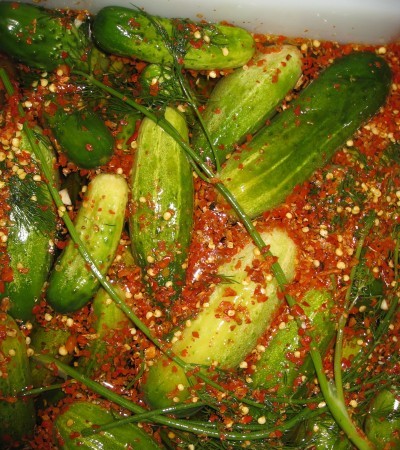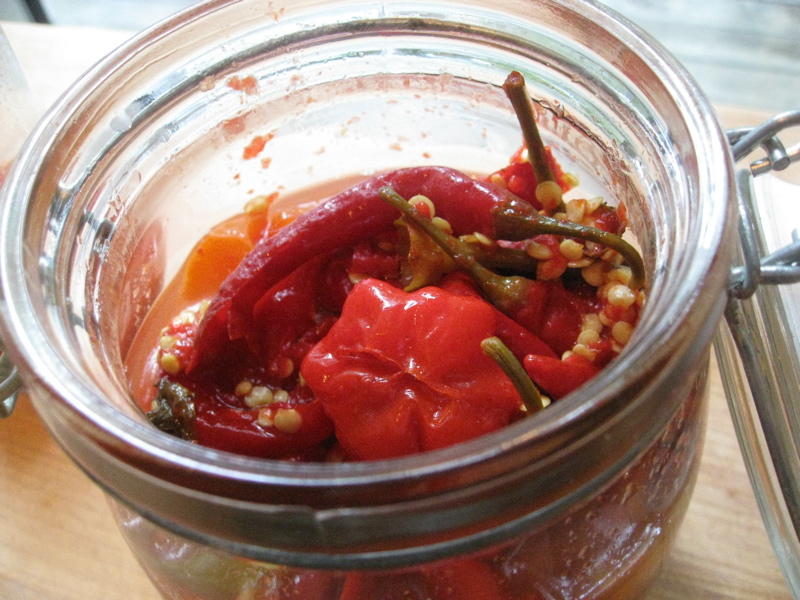 Yes, you can (preserve your own peppers). All photos by April McGreger
Yes, you can (preserve your own peppers). All photos by April McGreger
Judging from the first canning-equipment display I’ve ever seen at my local health-food store, home canning is undergoing a revival. Let us not forget, though, that long before Ball and Kerr were churning out jars, food preservation was a common practice. Traditional cultures all over the world preserved much of the food needed for the winter through lactic-acid fermentation. Sauerkraut, kimchi, grape leaves, cucumbers, turnips, green tomatoes, peppers, corn, and many, many more vegetables were commonly preserved through this process.
Of all methods of preserving, lacto-fermentation is the most magical. At its simplest, it is just vegetables and salt. This provides the right conditions for nature to take its course. The salt slows the decomposition of the vegetables briefly until the sugars in the vegetables are broken down by friendly lactobacilli and converted into lactic acid to preserve the vegetables for many months.
Thinking about real, lacto-fermented pickles makes my mouth water. There is no substitute for their complex and nuanced taste. I was born into sweet pickle territory, however, and grew up on bread and butters and apple cider vinegar-y okra pickles. Though delicious as well, that’s not what I am talking about here. Here we are talking about the artisanal crafted, slightly unpredictable, real thing.
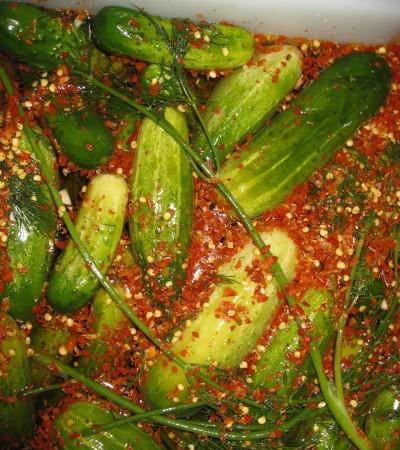 Not-so-classic dill pickles: just add chiles.My first encounter with real, garlicky, brined pickles was at the all-you-can-eat pickle bars of Jewish delis. Since then, my love of pickles has led me on pickle eating field trips to the Russian community of Brighton Beach, Brooklyn, where they serve massive slabs of whole pickled watermelon, to Japan, where I ate pickled umeboshi plum, daikon radish and burdock root for breakfast alongside bowls of rice and miso soup. I’ve also discovered some hidden fermenting traditions in my own region as well, such as the Appalachian tradition of pickling whole ears of corn on the cob, which has roots in Native American food ways, and the grape leaf pickles found around Winston-Salem, N.C., most likely connected to the Moravian settlement there.
Not-so-classic dill pickles: just add chiles.My first encounter with real, garlicky, brined pickles was at the all-you-can-eat pickle bars of Jewish delis. Since then, my love of pickles has led me on pickle eating field trips to the Russian community of Brighton Beach, Brooklyn, where they serve massive slabs of whole pickled watermelon, to Japan, where I ate pickled umeboshi plum, daikon radish and burdock root for breakfast alongside bowls of rice and miso soup. I’ve also discovered some hidden fermenting traditions in my own region as well, such as the Appalachian tradition of pickling whole ears of corn on the cob, which has roots in Native American food ways, and the grape leaf pickles found around Winston-Salem, N.C., most likely connected to the Moravian settlement there.
This is the perfect time of year to try your hand at fermented vegetables. The days are getting shorter, the nights cooler and temperatures are on the decline. However, harvests are still coming in. When fermentation temperatures rise above the low seventies, yeasts and mold growth on the surface of the pickles are more aggressive. Cucumbers, the vegetable most synonymous with pickles, prefer cooler summer temperatures and are plentiful at my market right now. Another of my favorite vegetables to ferment is peppers, and this is high pepper season. A fermented hot sauce has a sophisticated lingering flavor and not just heat. It might be bad news for the hot sauce business, but once you’ve made a homemade, fermented version, you may never buy another bottle of the stuff. Fermented sweet peppers are delicious on sandwiches, chopped into salads, tossed in a stir fry, and just about anywhere you choose to apply them.
If you want more information about this type of pickling, there is tons to explore. Unfortunately, there’s a lot of misinformation as well. I highly recommend Nourishing Traditions by Sally Fallon, Wild Fermentation by Sandor Katz, and The Joy of Pickling by Linda Zeidrich.
Before you begin, there are a couple of important things to remember when fermenting vegetables. First, be absolutely certain that your vegetables are fully submerged beneath the brine and sufficiently weighted down. If an errant cucumber is sticking out of the brine and exposed to air, yeast and mold are likely to flourish. Check your pickles regularly and immediately skim off any growth that does occur.
Yeast and mold are much more difficult to combat at warmer temperatures, which is why, along with the necessity of putting food by for winter months, fermentation is traditionally done in the fall. Temperatures between about 55 and 70 degrees Fahrenheit make the best pickles, but with careful monitoring I have successfully fermented at temperatures up to 80 degrees.
 In quite a pickle: not just for cukesMany traditional pickle makers believe that pickles need to be made when the moon is waning, so you might want to consult your lunar calendars as well.
In quite a pickle: not just for cukesMany traditional pickle makers believe that pickles need to be made when the moon is waning, so you might want to consult your lunar calendars as well.
Once fermented, the pickles will keep in your refrigerator for up to a year so long as they remain submerged in the brine.
Below, instead of giving you a specific recipe for fermenting pickles, I have attempted to give you a general guide and a ratio for brine that you can adapt endlessly. The saltier your brine, the longer your fermentation will take and the more sour your pickle will be. Below you will find my most commonly used ratio for brine. However, you can successfully cut the salt in half and still have pickling success. Your pickles will be not get as sour and will pickle in about half to three quarters of the time. This is how the half sour pickle of Jewish delis is made.
Lacto-fermented Pickles 101
The following guide will make two quarts of fermented vegetables. If you want to make 12 quarts of pickles, simply multiply everything by a factor of six.
Necessary Equipment: a stoneware crock; a food grade plastic bucket or other nonreactive container to hold your pickles, such as a large glass jar; a measuring cup and measuring spoons; and either a plate that will fit snuggly inside the rim of your container or two plastic Ziploc bags large enough to cover the surface of your pickling crock.
Ingredients: 2 pounds cucumbers or about 2 quarts of other vegetables, such as quartered green tomatoes; green or wax beans; thinly sliced carrots or beets; small peppers or pepper strips
Brine: 3 Tablespoons fine sea salt; 1 quart filtered water.
Suggested herbs and spices:
Garlic is a must in my opinion – 5-6 cloves, crushed, sliced, or chopped per quart of brine
Dill – a handful of dill heads or fronds per quart of brine
Black Peppercorns – 1 teaspoon whole peppercorns per quart of brine
Mustard Seed – 1/2 teaspoon per quart
Chile peppers – dried or fresh, 1-2 per quart of brine, or more if you dare
Bay leaves – 1 per quart of brine
For crunchier pickles – add a few grape or sour cherry leaves per quart of brine.
**A note on other spices — The sky is the limit with how you spice your pickle. My advice is to choose no more than three predominant, complimentary flavors that you want to accent in your pickle. I almost always use garlic. Try an Asian spiced pickle with Sichuan peppercorns and ginger, or a Mexican spiced pickle with jalapenos, cumin, and oregano. Mixed pickling spice gives pickles a spicier, old fashioned flavor. Create your own pickle based on your own favorite herbs and spices, such as horseradish, fennel, celery, basil, tarragon, or curry powder.
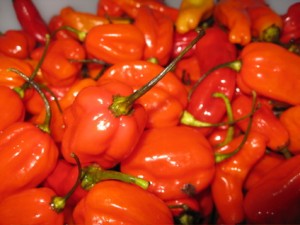 Pick a peck–then pickle ’em. Method:
Pick a peck–then pickle ’em. Method:
In a clean crock or other pickling vessel, layer your well washed vegetables and spices. Leave about 4 inches at the top of your crock. Prepare your brine with cold, filtered water. Whisk well to completely dissolve the salt and pour the brine over your vegetables. The brine should just cover your vegetables.
Next, you need to weight down your vegetables to keep them fully submerged in the brine. You can do this by using a plate that just fits inside your crock, thus creating a seal, and weighting that plate down with a well-scrubbed, large rock or several quart jars that have been filled with water.
Alternately, you can use a plastic bag filled with brine to act as both a weight and a seal. I often use this method. Fit a heavy 1-gallon plastic freezer bag inside another (for larger than 2 gallon crocks, I use the 2 ½ gallon bags). Fill the inner bag with a salt brine of 3 tablespoons salt to 1 quart of water and tightly close both bags to prevent leaks. Place on top of the pickles, making sure it fits tightly around the inner edge of the crock. It acts as an airtight weight on top of the vegetables, which will discourage the growth of yeast and scum. Store the crock in a cool place (60° to 75°F). Liquid may bubble and seep from the pickles as they ferment, so place the crock on a tray to contain any overflow.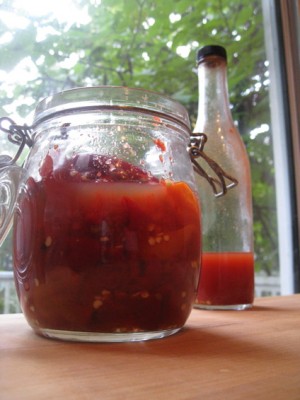 Now that’s hot
Now that’s hot
Your pickles will take about 4-10 days to complete fermentation, depending on the temperature of fermentation and the concentration of salt in your brine. Cooler temperatures and saltier brines slow fermentation. You will know that fermentation is complete when bubbles are no longer rising to the surface of your pickles and they have a fresh, tart smell. Taste the brine. If the saltiness is not balanced with sourness, you can let your pickles continue to ferment another day or two.
Truly Sensational Hot Sauce:
Ferment hot peppers, adding garlic for spicing, if you wish. Turn your fermented hot peppers into hot sauce by simply stemming and pureeing them. Be sure to wear gloves when handling hot peppers. If you want a thinner sauce, strain. Bottled sauce will keep all year in the refrigerator.

